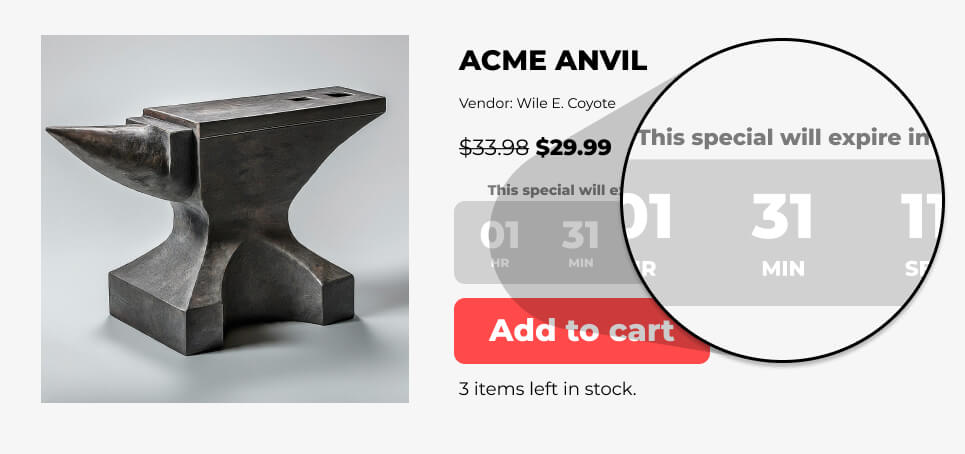In the fast-paced world of e-commerce, where attention spans are fleeting and competition is fierce, urgency marketing has become a popular tool to nudge customers towards a purchase.
It leverages the power of scarcity and time sensitivity to create a sense of urgency, encouraging immediate action.
Common urgency marketing tactics usually include one or more of the following:
Countdown Timers

In the case of the countdown timers, these visual timers tick down, highlighting the limited time window for a specific offer, like a flash sale or a discount code.
Stock Indicators

The Stock indicator elements show the remaining quantity of an item, creating a sense of scarcity and prompting customers to act before it's gone.
Limited-time Offers

Limited-time offers and promotions are available for a designated period only, urging customers to seize the opportunity before it disappears.
The Risks of Urgency Marketing
While these tactics can be effective in driving short-term sales, it's crucial to walk a fine line.
Overdoing urgency marketing can backfire, leading to panic buying, customers bombarded with constant pressure to buy might make impulsive decisions they later regret.
Trust erosion could also occur when frequent use of urgency tactics make customers feel manipulated, leading to a loss of trust in the brand.
If urgency becomes the sole focus of marketing efforts, it can overshadow the brand's core values and identity leading to brand image dilution.
How To Do It Right
The key to maximizing the impact of urgency marketing lies in elegant execution and brand alignment:
-
Align with Brand Values
Ensure urgency tactics seamlessly integrate with your brand's overall messaging and values. For example, a sustainable brand might offer limited-edition eco-friendly products to create excitement without sacrificing its core principles. -
Transparency is Key
Be upfront about the terms and conditions of any urgency offer. Clearly communicate the time constraints, product availability, and any associated limitations. -
Focus on Value, not Scarcity
While scarcity can be a motivator, the primary focus should be on the value proposition of the product or service. Highlight the benefits and features that truly resonate with your target audience. -
Leverage Urgency Ethically
Avoid creating a sense of false urgency. Fabricating limited stock or artificially inflating demand can damage brand reputation and hurt customer relationships. -
Prioritize Customer Experience
Remember, urgency marketing should enhance, not detract from the customer experience. Ensure clear information, smooth navigation, and a seamless checkout process to avoid frustration and cart abandonment.
By implementing urgency marketing with these principles in mind, businesses can effectively boost conversions. A well-timed and targeted urgency campaign can encourage customers to complete their purchase faster, leading to a temporary increase in conversion rates.
Clearing excess inventory is another great use of urgency, where it can be a strategic tool to move slow-moving items or clear out expiring stock, optimizing inventory management.
You can even generate excitement and anticipation. Limited-time offers can create a sense of excitement and anticipation around new product launches or exclusive promotions.
However, it's crucial to remember that urgency marketing is a tool, not a strategy. It should be used sparingly and strategically, alongside other well-defined marketing tactics for long-term success. Building trust and fostering genuine customer relationships should always be the foundation of any marketing effort, and urgency tactics should be employed in a way that complements, not undermines, this core principle.
By walking the tightrope between urgency and trust, businesses can harness the power of this marketing tool to achieve their sales goals while building strong and sustainable customer relationships.
If you need guidance on making use of urgency marketing, please do reach out to us here or simply email us.
Photo by insung yoon.